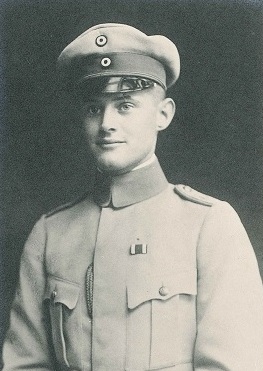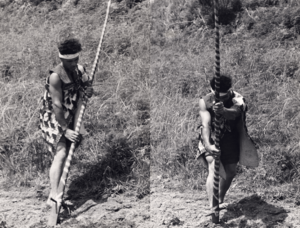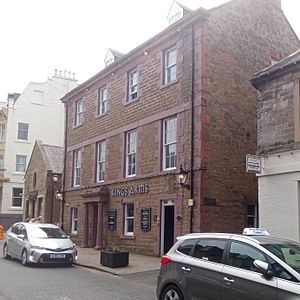Werner Kissling facts for kids
Quick facts for kids
Werner Kissling
|
|
|---|---|

after volunteering in 1914
|
|
| Born | April 11, 1895 |
| Died | February 3, 1988 |
| Nationality | German |
| Occupation | soldier, diplomatic, ethnographer |
| Parent(s) | Johanna Kissling |
Werner Friedrich Theodor Kissling (born April 11, 1895, in Wrocław, Germany – died February 3, 1988, in Dumfries, Scotland) was a special kind of scientist called an ethnographer. Ethnographers study different cultures and people. Werner was also a talented photographer. His mother, Johanna, was also a photographer and very important in his life. Both Werner and Johanna were well-known for their work in Scotland.
Werner studied many different groups of people. He looked at the crofters (small farmers) in Eriskay and South Uist in Scotland. He also studied farmers and fishers in Dumfries and Galloway. Far away, he learned about the Māori in New Zealand. He even explored the culture of North Yorkshire in England.
Werner Kissling was born into a very rich family. They owned a lot of land. But he spent all his money and ended up living in a care home in Dumfries. When he was in his twenties, he was a German diplomat, which meant he worked for his country in other nations. He was rich and had an important job. But he chose to follow his passion for studying people and taking photos instead.
Kissling is famous for a short film called Eriskay: A Poem of Remote Lives. This film uses his own video clips from 1934. It shows the daily life of crofters on the island of Eriskay in the Western Isles of Scotland. His mother, Johanna, was also a photographer and a big influence on him. In 1905, she visited the Western Isles and sent a postcard to Werner, who was 10 years old and back in Germany. When Werner died 83 years later, that same postcard was found in his suitcase.
Contents
Early Life and His Career Journey
Werner Kissling was born on April 11, 1895. His birthplace was near Breslau in Silesia. At that time, this area was part of the German Empire. Today, it is in Poland. Werner was the second son in a very wealthy family. They were aristocrats who owned land and breweries. His mother was Johanna Kissling. His father was the great-grandson of the person who started the rich brewing company, Conrad Kissling KG, in 1835.
Werner went to school in Breslau and Leobschütz (now Głubczyce in Poland). He spent a lot of his younger years at an old palace. This palace was called the 'Marshes' and was in the village of Heinzendorf. Today, this village is called Bagno in Poland. Werner's father bought Bagno Palace in 1905. He made it bigger and fixed it up. The 'Marshes' stayed in the family until 1927. Werner's older brother, Georg Conrad, had to sell it then. The family was having money problems.
From Soldier to Diplomat
After serving in the army during World War I, Werner went to university. He studied international law and history. He went to the Friedrich-Wilhelm University in Berlin. He also studied at the University of Königsberg (now Kaliningrad in Russia). After his studies, he became a diplomat for Germany. He trained at the Consular School in Vienna.
His first job as a diplomat was in Latvia. This is where he took his earliest photos that we still have today. He also worked in Spain, Hungary, Switzerland, and the UK. He was even part of the German group that went to the League of Nations. This was an organization that tried to keep peace in the world.
In 1931, Kissling came to Britain. He worked at the German embassy in London. This was his last job as a diplomat. He would never go back to Germany. The Nazi Party was growing strong in Germany. This worried him a lot. After Adolf Hitler took power in 1933, Kissling had to quit his job. A librarian named Ralph Coleman, who knew Kissling later, shared a story. He said that Hitler called Werner and told him his army group needed him. Werner replied that his group no longer existed. Hitler then called him a traitor. Werner answered that he might be a traitor to Hitler, but not to his country.
Kissling then moved to Cambridge. He got a job as 'Keeper of Collections' at the Museum of Archaeology and Ethnology.
Exploring Scotland's Islands
Less than a year later, Kissling decided to move again. Hitler's secret police were watching him. He borrowed a friend's yacht, named Elspeth. He also brought his Leica camera and a movie camera. He sailed to the Western Isles of Scotland for safety. He had visited these islands before. Kissling was very interested in the old-style houses. The Hebridean blackhouse of the Western Isles became very important in his work. He even lived in one of these simple houses for three months. It was very different from his rich home in Germany. During this time, he took many photos. He also filmed daily life on the islands. This film became the basis for Eriskay: A Poem of Remote Lives.
Four years later, in 1938, Kissling traveled to New Zealand. He paid for this trip himself. There, he took photos of the traditional skills of the Māori people. More than 400 of these photos are now in the British Museum. He also reportedly filmed the Māori people, but this film has not been found.
When World War II started in 1939, Kissling returned to Britain. Because he was a former German diplomat, he was held in the Tower of London. However, the British knew he was against the Nazis. He was later moved to a camp on the Isle of Man. There, he was even made a welfare officer for other Germans held in the camp. He was set free in 1942. He then went back to Cambridge to continue his work studying cultures.
Later Life and Work
In 1945, Kissling helped his mother, Johanna, leave Germany. She brought the family's fortune, which was a lot of money. But the money was not managed well. Most of it was gone by the time his mother died 16 years later. This was partly because of a failed hotel business. In 1952, he bought the Kings Arms Hotel in Melrose in the Scottish Borders.
Between 1952 and 1961, Kissling worked part-time. He was a writer and photographer for the School of Scottish Studies. He took pictures of traditional skills in the Hebrides, the Scottish Borders, and southwest Scotland. From 1962 to 1966, Kissling went to North Yorkshire every summer. He spent three months there taking photos for the University of Leeds. In 1967, he mostly worked as a research assistant at the English Institute of Dialect and Folk Life Studies.
In 1968, Kissling moved to Dumfries. He spent the last 20 years of his life there. He worked as an anthropologist and photographer for the town's Burgh Museum. He worked from a small building attached to the museum. He also kept adding to the Camera Obscura collection. Werner, with his silver hair, would travel around in his old van. He photographed traditional country crafts and collected many old items. During this time, he also sold photos and negatives to earn money. Many of his works are now in different collections.
Eriskay: A Poem of Remote Lives Film
Werner Kissling spent the summer of 1934 on the island of Eriskay. This island is in the Western Isles of Scotland. He took many photos and also filmed the traditional way of life there. His film shows the islanders in 1934. It observes them doing their daily tasks, which changed with the seasons. You can see scenes of people collecting peat (a type of fuel). There are also scenes of sheep shearing and dipping. People are shown repairing fishing nets. The film also shows how tweel (tweed fabric) was made. This includes collecting crottle, which is a type of lichen used for dye. You can also see the 'waulking of the tweed', a process where people shrink and thicken the fabric by hand.
These scenes of the islanders working are mixed with wide shots of the island. You can see its bays and the Eriskay fishing boats heading out to sea. The film also features the Eriskay Pony and Kissling's own yacht, Elspeth.
The film was put together to help raise money for the people of Eriskay. Kissling always cared about the islanders' problems. He was concerned about improving their roads and water supply. The finished film was called Eriskay: A Poem of Remote Lives. It was 15 minutes and 40 seconds long. It was originally a silent, black-and-white film. Later, an introduction was added with sound. This included narration, Scottish traditional music, and conversations in Scottish Gaelic.
Kissling's film was the main part of a special event. It was called a "Hebridean Evening." This event happened on April 30, 1935, in London. Important people like the Prince of Wales and Queen Mary of Teck were there. The money raised helped build Eriskay’s first main road. This road went from the old pier in the north to the harbor in the south. Even though the roads have been updated since then, part of the old road still exists. It is called Rathad Kissling, which means "Kissling Street."
The film was very popular at the time. But then it was forgotten for many years. It stayed in the archives of the School of Scottish Studies until the late 1970s.
Werner Kissling's Final Years
Werner Kissling passed away on February 3, 1988. He died without any money at the Moorheads Nursing Home in Dumfries. But he left behind one of the biggest collections of photos of the Scottish Hebrides. In his room, a single suitcase was found. It was full of his personal papers, photos, and slides. These items showed his deep connection with the people of the Western Isles. Also in the suitcase was that old postcard. His mother had sent it from the Isle of Lewis in 1905. This postcard must have started his love for the Hebrides, a love that lasted his whole life.
Kissling was buried in an unmarked grave in St Michael's kirkyard in Dumfries. It was very close to the grave of the famous poet Robert Burns. Two years after Werner died, Ralph Coleman, the Dumfries librarian, organized a way to raise money for a gravestone. They collected £500 for a simple granite headstone. It was carved with these words: SOLDIER, DIPLOMAT, SCHOLAR, GENTLEMAN. Coleman said these words fit him perfectly. He called Werner an "amazing man" who understood what Nazism meant for Europe.
Alfred Truckell, who used to be the curator of the Dumfries museum, called Kissling "a brilliant man." He said Werner's interests were wide and important around the world. He added that Werner took "magnificent photographs." One photo he thought was especially brilliant showed the Red Army crossing a bridge in Riga. He also made a wonderful film about the Māori people in New Zealand. And he spent three months living in a black house to truly understand the life of crofters.
Werner was a private person. He did not want public praise for himself or his work while he was alive. Mr. David Lockwood, another Dumfries museum curator, wrote in Kissling's obituary. He said Werner saw his research as "a race against time." He only stopped working when he became too sick with arthritis.
BBC Alba, a Scottish TV channel, made a documentary about Werner Kissling. It was called “Kissling - Duin' Ioma Fhillte.” Michael Russell helped produce the film. It was first shown in November 2009.
His Mother's Legacy
In November 2022, Werner's mother, Johanna Kissling's, work was shown. It was part of the GLEAN exhibition at Edinburgh's City Art Centre. This exhibition featured 14 early women photographers who worked in Scotland. The photos and films were put together by Jenny Brownrigg. They included works by Helen Biggar, Violet Banks, Christina Broom, Mary Ethel Muir Donaldson, Dr Beatrice Garvie, Jenny Gilbertson, Isabel Frances Grant, Ruby Grierson, Marion Grierson, Isobel Wylie Hutchison, Johanna Kissling, Isabell Burton-MacKenzie, Margaret Fay Shaw, and Margaret Watkins.
Films
- Eriskay: A Poem of Remote Lives, 1934 (see video in External Links)
Collections
- Dumfries Museum
- Dr Kissling's life and family photographs
- A 1978 exhibition of Dr Kissling's photographs with his own original captions
- Dr Kissling's photographs of blacksmithing in Dumfries and Galloway
- British Museum – New Zealand Photographs and Negatives
- Leeds Archive of Vernacular Culture - Yorkshire
- The Māori photographs of Werner Kissling by Amiria Salmond
- Haddon Photographic Collection
Publications
- The Character and purpose of the Hebridean Black House J.R.A.I., Vol. LXXIII, Royal Anthropological Institute, 1943
- Kissling, Werner: 'House Traditions in the Outer Hebrides. The Black House and the Beehive Hut', Man, Vol. XLIV, 1944




